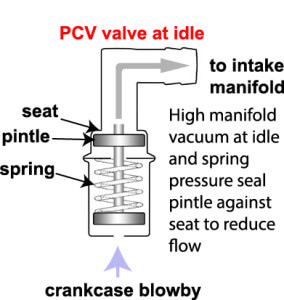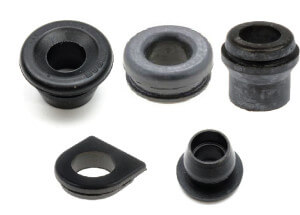Replace a PCV valve
Replace a PCV valve yourself
What does a PCV valve do?
Your engine uses a PCV valve to regulate the flow of harmful vapors from the crankcase and direct them into the intake manifold where they can be burned. The valve is a wear item and you have to replace the valve at specified intervals.
The Positive Crankcase Ventilation (PCV) system in auto engines is designed to remove harmful vapors from the crankcase and prevent them from venting to the atmosphere. One end of the PCV valve is attached to the engine and the other to manifold vacuum. When the engine is running, crankcase vapors are sucked into the intake manifold and mixed with the fresh air/fuel mixture to be burned in the combustion chamber.
PCV systems have been used as an emissions control device since 1963. Before that, engines simply dumped crankcase vapors into the atmosphere where they contributed to smog. There are two types of PCV systems.
Open PCV Systems
An open PCV system pulls in fresh air though a vented oil filler cap. This system works as long as the engine doesn’t produce excessive amounts of blowby. When that happens the PCV system actually pumps the vapors back through the vented oil filter cap and into the atmosphere.
Closed PCV Systems
Most vehicles now use a closed PCV system that draws replacement fresh air from the air filter housing. The oil filler is sealed. This closed system prevents vapor reaching the atmosphere.
How the PCV Valve works
The PCV’s job is to meter the flow of the vapors from the crankcase to the intake manifold. The flow rate of the valve is tailored to the engine. In other words, it is application specific. If you replace a valve with the wrong one, you can create excess flow or restrict the flow. Why do you care?
Well, introducing too much outside air into the crankcase can accelerate the formation of sludge. Even though the new air if filtered by the air filter, it still carries moisture. That moisture combines with oil in the crankcase and assists in sludge formation. In addition, excessive air flow upsets the proper air/fuel mixture in the intake manifold. The engine computer expects a certain flow rate from the valve at idle and cruise. If you replace the valve with the wrong one, or the current valve becomes restricted due to varnish, oil, or sludge buildup, the computer won’t know that and the reduced flow will affect engine performance. The key here is that a properly designed PCV system should remove crankcase vapors at about the same rate they’re created.
PCV valve operation at idle

At idle the PCV valve restricts airflow
Blowby is minimal at idle and manifold vacuum is high, so the spring in the PCV valve pushes the pintle towards the seat to reduce air flow.
Valve operation at cruising speeds
PCV operation at cruising speeds
As you increase engine RPMS and manifold vacuum falls, the spring pushes the pintle away from the seat, allowing more air to flow.
Valve operation during a backfire
The valve closes to prevent a backfire from igniting crankcase vapors and damaging your engine
If engine or ignition timing are off or a valve sticks, the engine may experience a backfire. The PCV valve is designed to close to prevent flames from entering the crankcase and igniting the flammable vapors and damaging the engine.
What goes wrong with a PCV valve?
Since the PCV valve is a flow control device for crankcase blowby vapors, it’s subjected to varnish, oil, and sludge buildup. Those accumulations can impede the movement of the pintle. As a result, the pintle may not move towards the seat at idle, allowing too much airflow and, in effect, looking like a vacuum leak to the computer. This unexpected and unmetered air will cause the computer to enrich the mixture and that will cause a higher than expected idle speeds.
Likewise, if the spring and pintle don’t move properly at cruising speeds, the engine will experience reduced airflow and crankcase pressures will build. That causes two problems; oil leaks at gaskets due to increased crankcase pressure, and a slightly learner mixture than the computer expects to see.
Servicing a PCV valve
How do you know if your PCV needs replacement? First, consult the maintenance guide. Some engines require PCV replacement as often as 30,000 miles,
Find the correct PCV valve for your engine and replace it.
while others recommend replacement at up to 60,000 miles. Many times you can remove the PCV valve and shake it. If the pintel and spring are operating properly you’ll hear distinct metallic sounds. If it’s gummed up with sludge or varnish, it’ll sound squishy. If in doubt, replace the PCV valve. They cost less than $10, unless your vehicle has the newer heated design.
Never try to clean the PCV valve. You may succeed in removing some of the varnish buildup, but you’ll never really know if you’ve removed all of it. Plus, you don’t know how much the spring and the pintle seat have worn.
Replace the PCV valve grommet as well.
Over time the PCV valve grommet can harden and

PCV valve grommets come in many different shapes
crack, creating a leak. Auto parts stores sell replacement grommets and they’re easy to install, so check the condition of your grommet and replace it if it appears hard or cracked.
©, 2015 Rick Muscoplat
Posted on by Rick Muscoplat